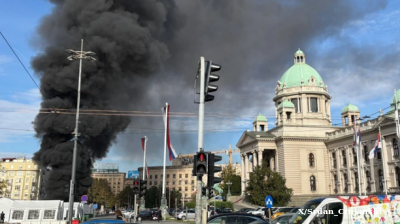Data analysis by Levan Kvirkvelia of GetWebIntelligence and Roman Udot, an independent election observer and data analyst, backs up opposition claims of widespread fraud in Georgia’s October 26 general election.
Kvirkvelia argued in a series of posts on X (formerly Twitter) that deviations in voting patterns, particularly in rural areas, strongly indicate irregularities compared to typical voting distributions, hinting at possible ballot stuffing or miscounting favouring the ruling Georgian Dream (GD) party.
According to figures released by the Central Election Commission (CEC), GD took 54% of the vote. Meanwhile the opposition parties that crossed the 5%-threshold in terms of vote share garnered around 37% of the vote overall. These included the Coalition for Change (11%), United National Movement (UNM, 10%), Strong Georgia (9%) and For Georgia (8%).
The opposition has rejected the results, however, calling the election “stolen” and accusing GD of rigging the vote to maintain its grip on power.
The “Russian tail”
A chart shared by Kvirkvelia on X, tweeting as @LevanKvirkvelia, reveals a so-called “Russian tail”, a statistical anomaly commonly associated with manipulated elections.

Source: Levan Kvirkvelia via X.
Every dot on the chart represents how many voting locations recorded a particular percentage of votes for the ruling party, he explained. In a fair election, the distribution should follow a bell curve, with most locations hovering around the average percentage of votes for the government.
In contrast, the Georgian election data shows a substantial "tail" to the right in rural areas, where GD's support sharply increases to near-unanimous levels.
"Approximately 400 locations show unusually high support for the government," wrote Kvirkvelia.
This phenomenon is rare in fair elections, which are typically marked by a smooth distribution of votes. "It is virtually impossible for so many locations to naturally produce such a sharp spike, rather than a smooth trend,” he said.
Rural anomalies
Kvirkvelia’s other charts further support his claims by comparing voting behaviours between urban and rural areas.
On these charts, each dot represents a voting place, with the y-axis showing the percentage of registered voters who supported the ruling party and the x-axis showing overall turnout. For data consistency, the votes cannot exceed the number of people who voted, so results should cluster around the expected turnout-support percentage.
This clustering effect, Kvirkvelia pointed out, is evident in urban voting areas, where data points fall close to the trend line.

Source: Levan Kvirkvelia via X.
However, in rural districts there is a marked deviation: hundreds of locations reported full turnout with unanimous support for GD.

Source: Levan Kvirkvelia via X.
“In rural areas the ruling party has many data points deviating significantly from the trend line,” wrote Kvirkvelia.
“In hundreds of small and large locations, 100 voters show up, and all 100 vote for the ruling party – a scenario that is almost unreal in fair elections.”
He concluded: “This data provides solid evidence supporting the argument of ballot stuffing/miscounting This manipulation occurred exclusively in rural areas, and we can say that the ruling party committed electoral fraud.”
Devil in the details
Analysis of the results by Roman Udot, an independent election observer and data analyst, appears to confirm the anomalies pointed out by Kvirkvelia.
“Although the overall statistical impression of the elections in Georgia was positive … the devil, as usual, was in the details,” Udot wrote on X.
Like Kvirkvelia, Udot worked with data from the Georgian election using the Sobyanin-Sukhovolski hypothesis, that plots turnout against the number of votes for a candidate or party.
In a fair election, the slope corresponds to the candidate’s actual support level. However, in cases of ballot stuffing, the slope approaches 45°, and in cases of mis-recording, when votes given to the beneficiary by taking them away from rivals, other parties, the slope steepens further for the favoured candidate.
Comparing the results for the major urban areas of Tbilisi, Rustavi, Kutaisi, Poti and Batumi with the rest of the country reveals that the Sobyanin-Sukhovolski hypothesis holds for urban but not rural areas, as shown by Udot in posts on X, where he tweets as @romanik_.

Source: Roman Udot via X.
“This discrepancy suggests a basis for suspecting fraud in Group 2 [rural areas], while no such grounds were observed in Group 1 [urban areas],” wrote Udot.

Source: Roman Udot via X.
Protests planned
Opposition politicians and activists as well as independent observers have already pointed to multiple violations during the election, including ballot stuffing, voter manipulation and carousel voting.
Among the most vocal critics is President Salome Zourabichvili who told a briefing on October 27 that the election outcome was a “total falsification, total stealing of your votes”.
She went on to claim that "Georgia is the victim of a Russian ‘special operation’.”
The opposition have pledged to take to the streets to contest the result, with the first protest in Tbilisi planned for the evening of October 28.
News

Serbian president calls fire, shooting outside parliament a terrorist attack
The attacker, a retired employee of the former State Security Service, opened fire on a tent settlement of pro-government supporters.

Bolivia's new leader must rebuild a shattered economy
Bolivia enters a new political and economic phase as centrist Rodrigo Paz prepares to take office on November 8, inheriting one of the country’s most acute crises since the hyperinflation of the 1980s.

Hungarian foreign minister says "many actors" worked to prevent Budapest summit
The White House has suspended plans for a meeting between US President Donald Trump and Russian President Vladimir Putin in Budapest.

Central Asian states registering impressive trade gains
Success despite the lack of access to a seaport.




